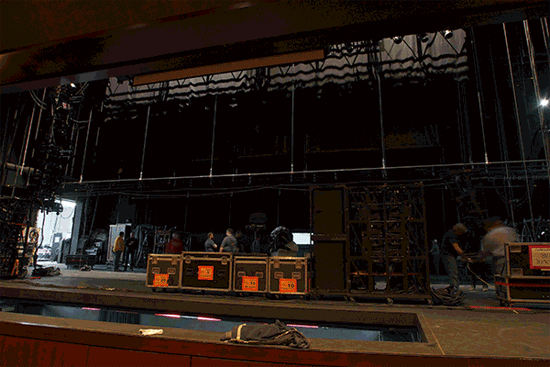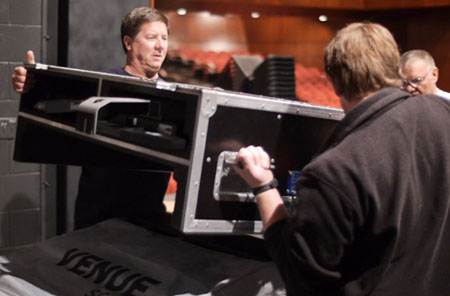Putting on a show at NPAC challenging
DAVE MOSIER/independent editor
Many older people likely remember a trio of movies starring Mickey Rooney and Judy Garland that involved neighborhood kids putting on Broadway-quality shows in their backyard and making it look easy.

Ask Niswonger Performing Arts Center Executive Director Paul Hoverman and his cadre of four full-time employees about what it takes to do the same at the NPAC and you get a different picture. The reality is that NPAC shows — particularly the multi-semi truckload shows such as Memphis, coming to the Central Insurance Stage this weekend — involve myriad details, hundreds of hours of planning and literally thousands of volunteer man-hours.
The process begins when Hoverman, the first and only director of the NPAC since its opening in 2007, prepares his list of possible shows to produce for the coming season, following discussions with members of the Van Wert Area Performing Arts Foundation’s Programming Committee.
“I tell what I’d like to do,” Hoverman said of the discussions, with shows often based on ideas that come from committee members, as well as shows Hoverman and others have seen personally.
“That’s one reason I wanted to do Memphis, since I had seen it and knew what a great show it was,” Hoverman said.
Once a potential list is created, Hoverman and Technical Director Hugh Saunier, who has also had that job since the NPAC opened, go over the technical requirements for each show. That means looking at a list of workers required for the show as well as reviewing a stage diagram that details where everything to be placed on stage will be located.
After reviewing the technical requirements, Saunier creates a technical budget estimating what it would cost to stage the show — and if the show’s needs fit the NPAC’s resources.
As part of the technical budget, Saunier looks at what staffing needs a show will require, as well as equipment rental costs., since musical groups that fly from show to show often don’t take drums, keyboards and other musical equipment with them. Saunier said that groups do provide venues like the Niswonger with a list of equipment required, including, in some cases, the specific brand of drums or keyboards, etc., needed.
Each show will also need a group of volunteers to help with staging requirements. Technical staffing needs can range from three or four people for a one-person show, such as the recent Sinbad and Pat Boone shows, up to more than 50 people for Broadway productions such as Annie, Fiddler on the Roof and the upcoming Memphis, including wardrobe people, hairdressers and makeup people, carpenters, electricians, people to handle props and other staging needs.
Saunier said he tries to use volunteers when possible, but sometimes has to hire professionals from a local stage workers union if volunteers aren’t enough. However, doing so adds to the cost of a production and must be factored into the technical budget.
Once the technical budget is completed, Facilities Manager Mark Hartman, who handles the non-technical aspects of facility needs, gets involved. Hartman handles the needs of the artists, including “hospitality,” which could mean transportation needs, booking a hotel and securing catering for members of the show. Hartman, like Saunier, has a core group of volunteers he can call to help with facility needs, like picking an artist up at the airport.
Hartman said it’s important to him to ensure that artists are well taken care of.
“We try to take the best care we can of the performers and stay within the budget,” he noted. “From the feedback we get from artists at the end of the day, most feel they’ve been well taken care of.”
Artists usually stay at local or area hotels and catering generally comes from a number of local or area restaurants and food operations. For the recent Newsboys concert, Bob Evans Restaurant provided breakfast, while Collins Fine Foods catered lunch and Willow Bend Country Club provided dinner for the group and its entourage.
Hartman also must look at other staffing needs for a show, including ticket takers, ushers and those distributing programs, as well as concessions workers and any help needed for lobby merchandising kiosks.
Marketing Director Tafi Stober is also consulted by Hoverman and she develops a marketing budget that provides information on what marketing groups might be targeted for a particular show, as well as what types of advertising may be used in marketing a show.
After he receives information from Saunier, Hartman and Stober, Hoverman then puts together a total show budget and sets ticket prices for the show, based on a minimum number of tickets needed for a show to “break even”.
After ticket prices are set, Ticket Manager Jerry Beard goes into action, entering each show’s ticket information into the NPAC’s online ticketing program. He also estimates how many volunteers he’ll need to man the ticketing office during each season.
Beard, who worked in the customer service and finance departments of Eaton Corporation for more than 40 years, said ticketing staff needs are heaviest when the NPAC’s Select Series promotion takes off. At that time, Beard brings in all nine of his volunteers to man phones and the ticket office, where patrons are lined up to purchase tickets for the popular promotion, which allows people to purchase a group of shows and save a percentage off the ticket prices. Tickets can be purchased for 3-5 shows at a 10-percent savings and six or more shows for a 15-percent savings.
In addition to the Select Series, the NPAC also offers its Grand Series (tickets for all shows in a season at a 20-percent savings), as well as the Community Concert Series, which includes six events packaged together for as low as $60.
There are also a number of membership options, as well as corporate and individual sponsorship opportunities.
Beard, the oldest member of the NPAC staff, said that, while he may take a little more time off to travel with his wife, who retired three years ago, he doesn’t think about his own retirement.
“I enjoy meeting people too much,” Beard said, adding that one of his favorite duties is to take prospective ticket buyers on a tour of the facility and show them what seating options are available.
Once preliminary work for a show is complete, Saunier, Hartman and Beard ready their staffs for the actual day of the show.

The technical aspect of the show is usually the most demanding, especially for the big Broadway shows. Typically, a Broadway show will bring its semi-loads of gear in about 7:30 a.m. and work will begin immediately to unload the trucks and begin working on staging requirements. Saunier said lighting and backdrops — anything that will be lifted above the stage — are done first, followed by construction of sets and any other items needed to stage a production.
That takes a large corps of volunteers, who generally work under the supervision of professionals (head electrician, head carpenter, set designer) who travel with a show.
“What the average ticket buyer doesn’t realize is that, at 9 a.m., nothing is on the stage yet,” said Saunier, who has worked hard to learn the ins and outs, as well as the jargon, of stage production through work he has done on other productions in Fort Wayne, Indiana, and Dayton.
For a show such as Shrek: The Musical, which had two performances, with the first starting at 2 p.m., volunteers were on the job at 5 a.m. Teardown after the show also can last until 2 a.m.
Saunier added that a lot of flexibility is also needed, since things don’t always go as planned. One of those unplanned challenges came with the production of Annie, when it was found that a huge staircase used in the production wouldn’t fit into the NPAC stage configuration. The scene then had to be revamped to work without the staircase.
While technical workers are literally putting the production together, Hartman and his volunteers are putting out food, beverages and other needs for the artists and workers. Staff needed for the performance itself typically meet more than an hour prior to the show to go over assignments and details of the show, such as whether there is an intermission, and for how long, as well as the late seating policy and other aspects of each individual show.
One common theme that runs through every aspect of the NPAC is the critical park volunteers play in the process.
“We literally couldn’t do what we do without our volunteers,” Hoverman said, while Saunier, Hartman and Beard emphatically agreed.
“They’re a great group, they do a wonderful job,” Hartman said of his cadre of approximately 135 volunteers, while Saunier was also hugely complimentary of his volunteer technical staff.
The mix of paid staff members who care very much about what they do and highly-motivated volunteers has been very successful — so successful, in fact, that area venues and communities wanting to build their own performing arts center visit the NPAC regularly to see how things are done here.
POSTED: 03/26/15 at 7:52 am. FILED UNDER: News







